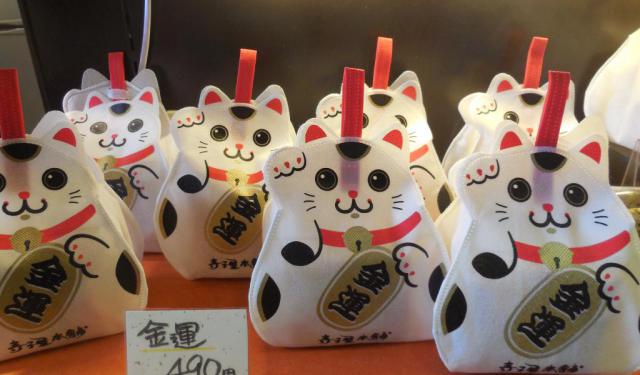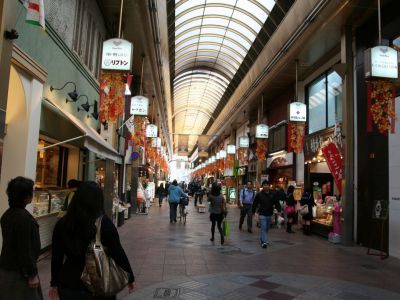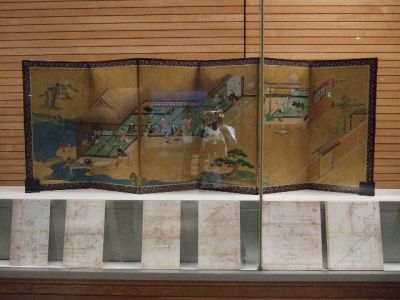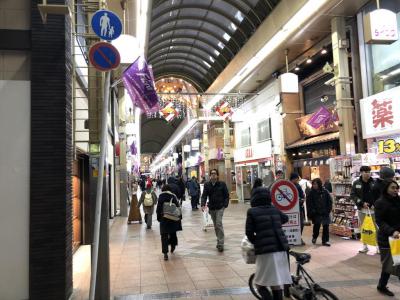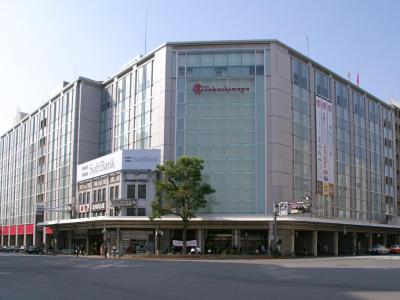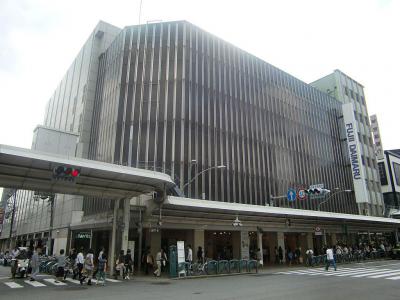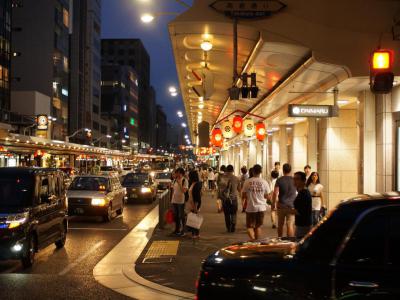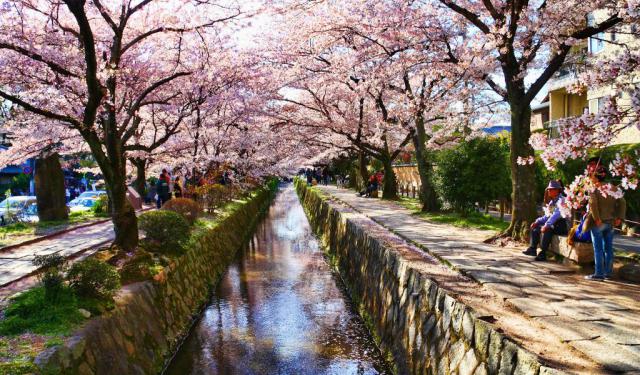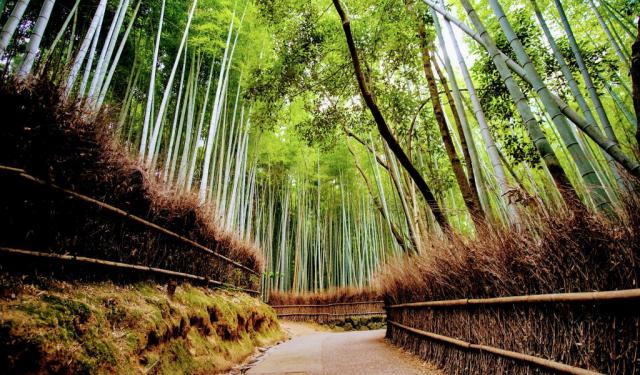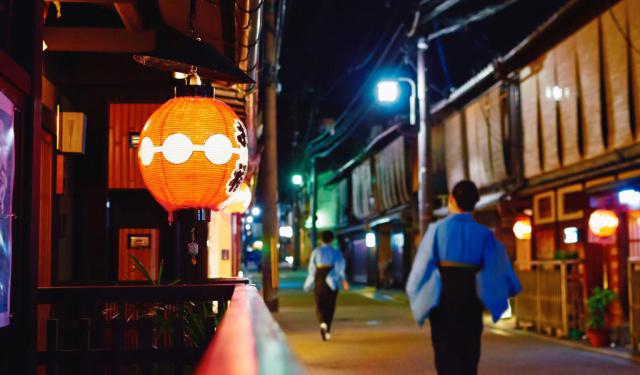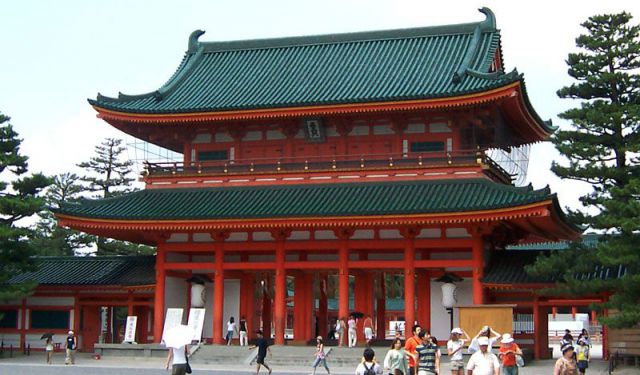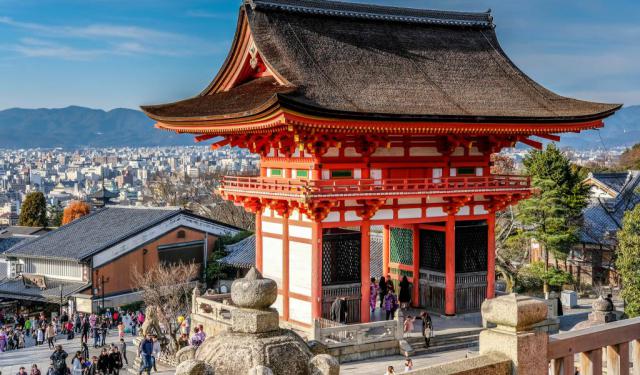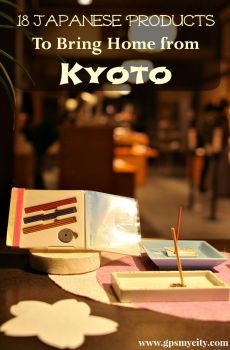Kyoto Shopping and Food Tour (Self Guided), Kyoto
The cultural capital of Japan, Kyoto is just as famous as a shopper’s paradise and, without a doubt, the best place in the country to buy traditional and modern Japanese goods. Souvenirs, food, bargains, and various “one-of-a-kind items” are all up for grabs here.
In addition to its shopping scene, Kyoto boasts a rich culinary heritage, from Michelin-starred restaurants to humble street stalls. Traditional Kyoto cuisine, known as Kyo-ryori (meaning “Today's Cooking”), emphasizes seasonal ingredients and delicate flavors, providing a truly authentic dining experience.
Nishiki Market stands out as a bustling hub of culinary delights, where visitors can sample a wide array of local delicacies, including fresh seafood, pickled vegetables, and traditional sweets. It's a sensory journey through the heart of Kyoto's culinary culture.
For art enthusiasts, Daishodo Woodblock Prints is a must-visit, showcasing intricate woodblock prints that capture the essence of Japanese aesthetics. The Shinkyogoku Shopping Street presents a vibrant tapestry of shops selling everything from stylish apparel to keepsakes, providing ample opportunities for souvenir hunting and fashion indulgence.
For those seeking a more upscale shopping experience, Takashimaya and Daimaru Department Stores are the go-to destinations. Here, shoppers can find a curated selection of luxury goods, cosmetics, and gourmet foods, all under one roof. Meanwhile, Shijo-dori Avenue exudes elegance with its wide boulevards lined with designer boutiques and upmarket eateries, offering a taste of Kyoto's modern sophistication.
Shopping and food in Kyoto offer a delightful blend of traditional charm and modern convenience, making it an enticing destination for travelers. If you would like to walk around Kyoto on your own two feet and enjoy shopping and authentic Japanese cooking, follow this self-guided walk.
In addition to its shopping scene, Kyoto boasts a rich culinary heritage, from Michelin-starred restaurants to humble street stalls. Traditional Kyoto cuisine, known as Kyo-ryori (meaning “Today's Cooking”), emphasizes seasonal ingredients and delicate flavors, providing a truly authentic dining experience.
Nishiki Market stands out as a bustling hub of culinary delights, where visitors can sample a wide array of local delicacies, including fresh seafood, pickled vegetables, and traditional sweets. It's a sensory journey through the heart of Kyoto's culinary culture.
For art enthusiasts, Daishodo Woodblock Prints is a must-visit, showcasing intricate woodblock prints that capture the essence of Japanese aesthetics. The Shinkyogoku Shopping Street presents a vibrant tapestry of shops selling everything from stylish apparel to keepsakes, providing ample opportunities for souvenir hunting and fashion indulgence.
For those seeking a more upscale shopping experience, Takashimaya and Daimaru Department Stores are the go-to destinations. Here, shoppers can find a curated selection of luxury goods, cosmetics, and gourmet foods, all under one roof. Meanwhile, Shijo-dori Avenue exudes elegance with its wide boulevards lined with designer boutiques and upmarket eateries, offering a taste of Kyoto's modern sophistication.
Shopping and food in Kyoto offer a delightful blend of traditional charm and modern convenience, making it an enticing destination for travelers. If you would like to walk around Kyoto on your own two feet and enjoy shopping and authentic Japanese cooking, follow this self-guided walk.
How it works: Download the app "GPSmyCity: Walks in 1K+ Cities" from Apple App Store or Google Play Store to your mobile phone or tablet. The app turns your mobile device into a personal tour guide and its built-in GPS navigation functions guide you from one tour stop to next. The app works offline, so no data plan is needed when traveling abroad.
Kyoto Shopping and Food Tour Map
Guide Name: Kyoto Shopping and Food Tour
Guide Location: Japan » Kyoto (See other walking tours in Kyoto)
Guide Type: Self-guided Walking Tour (Sightseeing)
# of Attractions: 6
Tour Duration: 1 Hour(s)
Travel Distance: 2.0 Km or 1.2 Miles
Author: DanaOffice
Sight(s) Featured in This Guide:
Guide Location: Japan » Kyoto (See other walking tours in Kyoto)
Guide Type: Self-guided Walking Tour (Sightseeing)
# of Attractions: 6
Tour Duration: 1 Hour(s)
Travel Distance: 2.0 Km or 1.2 Miles
Author: DanaOffice
Sight(s) Featured in This Guide:
- Nishiki Market
- Daishodo Woodblock Prints
- Shinkyogoku Shopping Street
- Takashimaya Department Store
- Daimaru Department Store
- Shijo-dori Avenue
1) Nishiki Market (must see)
Stretching for five blocks, the covered arcade of Nishiki is a culinary wonderland accommodating over 120 stalls. With a legacy spanning more than five centuries, it has earned renown for its fresh, seasonal, and mouthwatering offerings, drawing locals and tourists alike. If you spy a queue forming, rest assured that it leads to something delectable worth sampling.
What truly surprises is the artful presentation of food, each item meticulously arranged to entice the senses. From Kyoto-style octopus to sashimi on sticks, and cinnamon mochi (rice balls) to charcoal-grilled eels, the array is nothing short of astounding. Indulge in green tea sweets, dried seafood, or chocolate croquet, and don't miss the "kyoyasai" pickles made from special Kyoto vegetables.
While modern shops have found their place, Nishiki retains its quaintness, with many stalls being family-run for generations. Beyond culinary treats, visitors can peruse craft shops for souvenirs, including the quality knives of Aritsugu, perfect for personalized engravings.
A quick stroll through the arcade can suffice for those pressed for time, but linger a while if you can, and savor the essence of Kyoto.
Tips:
Mindful of the bustling lunchtime crowds, opt for a visit during quieter hours if possible. Enjoy stand-and-snack delicacies, with some stalls offering free samples. Remember, etiquette dictates consuming food in front of the stall, as eating while walking is discouraged. And be wary of inflated prices on specialty items, as Nishiki Market's popularity among tourists often comes at a premium.
What truly surprises is the artful presentation of food, each item meticulously arranged to entice the senses. From Kyoto-style octopus to sashimi on sticks, and cinnamon mochi (rice balls) to charcoal-grilled eels, the array is nothing short of astounding. Indulge in green tea sweets, dried seafood, or chocolate croquet, and don't miss the "kyoyasai" pickles made from special Kyoto vegetables.
While modern shops have found their place, Nishiki retains its quaintness, with many stalls being family-run for generations. Beyond culinary treats, visitors can peruse craft shops for souvenirs, including the quality knives of Aritsugu, perfect for personalized engravings.
A quick stroll through the arcade can suffice for those pressed for time, but linger a while if you can, and savor the essence of Kyoto.
Tips:
Mindful of the bustling lunchtime crowds, opt for a visit during quieter hours if possible. Enjoy stand-and-snack delicacies, with some stalls offering free samples. Remember, etiquette dictates consuming food in front of the stall, as eating while walking is discouraged. And be wary of inflated prices on specialty items, as Nishiki Market's popularity among tourists often comes at a premium.
2) Daishodo Woodblock Prints
Ukiyo-e, those delightful Japanese woodblock prints that flourished from the 17th to the 20th century, offer quite a peek into the past.
Originally, "Ukiyo-e" had a somber twist, translating to "sad world" from its Buddhist roots. But by the 17th century, it got a makeover to "floating world", capturing a realm of fleeting joys and carefree living. These prints were the lifeblood of theaters, brothels, and portraits of heartthrobs and tea house darlings, all tinged with the Japanese love affair with nature.
As the 18th century rolled around, new printing techniques brought full-color marvels to life, giving birth to an array of landscapes, portraits, historical scenes, and theatrical spectacles. Today, Ukiyo-e make for fabulous souvenirs, whether as postcards or wall hangings.
Enter Daishodo, the go-to spot for Japanese antique books and Ukiyo-e prints galore. From dainty postcards to grand wall adornments, and from fresh reproductions to fragile originals dating back over a century, they've got it all. Plus, for those delicate vintage pieces, they'll even throw in a frame. It's a must-visit spot if you're after an authentic slice of Japan to take home.
Originally, "Ukiyo-e" had a somber twist, translating to "sad world" from its Buddhist roots. But by the 17th century, it got a makeover to "floating world", capturing a realm of fleeting joys and carefree living. These prints were the lifeblood of theaters, brothels, and portraits of heartthrobs and tea house darlings, all tinged with the Japanese love affair with nature.
As the 18th century rolled around, new printing techniques brought full-color marvels to life, giving birth to an array of landscapes, portraits, historical scenes, and theatrical spectacles. Today, Ukiyo-e make for fabulous souvenirs, whether as postcards or wall hangings.
Enter Daishodo, the go-to spot for Japanese antique books and Ukiyo-e prints galore. From dainty postcards to grand wall adornments, and from fresh reproductions to fragile originals dating back over a century, they've got it all. Plus, for those delicate vintage pieces, they'll even throw in a frame. It's a must-visit spot if you're after an authentic slice of Japan to take home.
3) Shinkyogoku Shopping Street
Right in the heart of downtown Kyoto, this popular covered pedestrian arcade runs parallel to Teramachi street to the east. Together with Teramachi, it forms Kyoto's main shopping district, but Shinkyogoku has its own distinct vibe catering more to younger tastes.
Here, street fashion takes center stage, and people watching is as common as window shopping. The arcade is filled with hidden shops accessible via escalators, inviting exploration. You'll find a variety of attractions, from "pachinko" parlors to cozy cat cafes and specialty stores offering a plethora of souvenirs, shoes, umbrellas, t-shirts, yukata (casual summer kimono), geta (traditional Japanese footwear), confectionery, character goods, and more. Prices are affordable, making it a hotspot for high-school and university students.
For those who enjoy snacking while shopping, Shinkyogoku is a paradise with its many restaurants and cafes offering street food delights. The whole district is a maze of pedestrian pathways, with small alleyways adding to its charm, blending the tacky with the traditional, and the present with the past. While wandering, you might also want to peek inside a temple nestled along the street.
Tip:
While online sources may suggest late closing times, in reality, most establishments start closing around 7 or 8 PM, so plan accordingly.
Here, street fashion takes center stage, and people watching is as common as window shopping. The arcade is filled with hidden shops accessible via escalators, inviting exploration. You'll find a variety of attractions, from "pachinko" parlors to cozy cat cafes and specialty stores offering a plethora of souvenirs, shoes, umbrellas, t-shirts, yukata (casual summer kimono), geta (traditional Japanese footwear), confectionery, character goods, and more. Prices are affordable, making it a hotspot for high-school and university students.
For those who enjoy snacking while shopping, Shinkyogoku is a paradise with its many restaurants and cafes offering street food delights. The whole district is a maze of pedestrian pathways, with small alleyways adding to its charm, blending the tacky with the traditional, and the present with the past. While wandering, you might also want to peek inside a temple nestled along the street.
Tip:
While online sources may suggest late closing times, in reality, most establishments start closing around 7 or 8 PM, so plan accordingly.
4) Takashimaya Department Store
On a rainy day when temple visits don't seem appealing, or when you're in the heart of the city craving a meal or a bit of retail therapy, Kyoto's premier department store could be the perfect solution, offering surprises that may pleasantly catch you off guard.
Start your exploration in the basement, where you'll encounter a vibrant array of food items that may be unfamiliar to Western palates. The stalls are packed closely together, creating a veritable Wonderland for food enthusiasts: from bento boxes and Asian delicacies to spices, sweets, and a blend of modern and traditional fare.
If your appetite is whetted, take the elevator to the 7th floor, where you'll discover a variety of Japanese restaurants alongside French, Italian, and Chinese options. But that's not all; you'll also find amenities such as post office, ATMs, and a travel agency. This eclectic mix extends throughout the store, with the 6th floor housing an art gallery and Buddhist altars alongside bedding, curtains, and kitchenware.
For those feeling a bit disoriented, the 1st floor offers an information desk (and currency exchange) alongside jewelry and makeup counters. Dedicated shopper take note: tax refunds are available for purchases over ¥5,000, and souvenirs can be conveniently shipped abroad. While prices may be slightly higher than elsewhere, the quality of the products and their presentation are assured.
Tip:
Arrive at 10 AM to witness a unique tradition-staff members bowing to customers as the doors open, a testament to Japan's deeply ingrained "Customer is God" ethos. It's a unique aspect of Japanese culture that often inspires wonder but certainly deserves appreciation.
Start your exploration in the basement, where you'll encounter a vibrant array of food items that may be unfamiliar to Western palates. The stalls are packed closely together, creating a veritable Wonderland for food enthusiasts: from bento boxes and Asian delicacies to spices, sweets, and a blend of modern and traditional fare.
If your appetite is whetted, take the elevator to the 7th floor, where you'll discover a variety of Japanese restaurants alongside French, Italian, and Chinese options. But that's not all; you'll also find amenities such as post office, ATMs, and a travel agency. This eclectic mix extends throughout the store, with the 6th floor housing an art gallery and Buddhist altars alongside bedding, curtains, and kitchenware.
For those feeling a bit disoriented, the 1st floor offers an information desk (and currency exchange) alongside jewelry and makeup counters. Dedicated shopper take note: tax refunds are available for purchases over ¥5,000, and souvenirs can be conveniently shipped abroad. While prices may be slightly higher than elsewhere, the quality of the products and their presentation are assured.
Tip:
Arrive at 10 AM to witness a unique tradition-staff members bowing to customers as the doors open, a testament to Japan's deeply ingrained "Customer is God" ethos. It's a unique aspect of Japanese culture that often inspires wonder but certainly deserves appreciation.
5) Daimaru Department Store
Japanese department store basements, fondly known as "depachika", are a gastronomic paradise waiting to be explored. Here, you'll encounter sprawling delis brimming with tantalizing ready-made meals and bento boxes, alongside dessert havens overflowing with delectable treats. From Kyoto's esteemed Japanese confectioneries to renowned French patisseries offering an array of chocolate delights, these culinary meccas are hotspots for both locals and visitors alike.
Among the top contenders is Daimaru, where every item shines with attention to flavor and presentation. Not only does the food taste divine, but the prices are refreshingly reasonable, making it a perfect choice for those craving authentic Japanese cuisine without denting their wallet. The staff here are known for their hospitality, always ready to guide you through any unfamiliar dishes with a smile.
Basement aside, prepare to lose track of time as you explore Daimaru's diverse product lineup. For the convenience of foreign visitors, the 7th floor houses a dedicated customer service center to assist with tax-free procedures, complete with an English floor map, complimentary Wi-Fi, and a foreign exchange machine adjacent to the information desk.
Tip:
On a sunny day, why not seize the opportunity to indulge in a picnic? Grab some ingredients from the "depachika" and head to the park for a memorable outdoor lunch experience.
Among the top contenders is Daimaru, where every item shines with attention to flavor and presentation. Not only does the food taste divine, but the prices are refreshingly reasonable, making it a perfect choice for those craving authentic Japanese cuisine without denting their wallet. The staff here are known for their hospitality, always ready to guide you through any unfamiliar dishes with a smile.
Basement aside, prepare to lose track of time as you explore Daimaru's diverse product lineup. For the convenience of foreign visitors, the 7th floor houses a dedicated customer service center to assist with tax-free procedures, complete with an English floor map, complimentary Wi-Fi, and a foreign exchange machine adjacent to the information desk.
Tip:
On a sunny day, why not seize the opportunity to indulge in a picnic? Grab some ingredients from the "depachika" and head to the park for a memorable outdoor lunch experience.
6) Shijo-dori Avenue
Also known as Kyoto's "Fourth Avenue", this busy thoroughfare slices through the city's heart from east to west. Offering everything from upscale boutiques to quaint eateries to shops brimming with traditional Japanese handicrafts, there's something to suit every taste.
The lengthy street has a pristine appearance, with wide sidewalks, elegant lamps, and informative signage. At its eastern terminus lies the charming Yasaka Shrine, marking the gateway to the famous Gion district. Originally a tad narrow, the street underwent expansion in 2015, making it more accessible and enjoyable for pedestrians. Flanked by awnings on both sides, it's a delightful promenade regardless of the weather, attracting a steady stream of tourists from near and far.
The busiest stretch spans from Karasuma-dori in the west, known for its business and banking district, to Higashioji-dori in the east, serving as the entryway to the Yasaka Shrine. The area between Kawaramachi-dori and Karasuma-dori is particularly commercialized, hosting established department stores like Daimaru and Takashimaya, as well as boutique shopping havens like Fujii Daimaru and Marui. Here, you'll find everything from fashion to traditional Kyoto garments, alongside tea shops, confectioneries, and souvenir stores.
Tip:
For a more relaxed and authentic experience, venture across the Kamo River to Shijo-dori's eastern side, and enjoy an array of shops offering both traditional and modern Japanese goods, each with its own unique twist. While you're at it, take time to also explore the charming side streets lined with buildings dating back to the 1960s.
The lengthy street has a pristine appearance, with wide sidewalks, elegant lamps, and informative signage. At its eastern terminus lies the charming Yasaka Shrine, marking the gateway to the famous Gion district. Originally a tad narrow, the street underwent expansion in 2015, making it more accessible and enjoyable for pedestrians. Flanked by awnings on both sides, it's a delightful promenade regardless of the weather, attracting a steady stream of tourists from near and far.
The busiest stretch spans from Karasuma-dori in the west, known for its business and banking district, to Higashioji-dori in the east, serving as the entryway to the Yasaka Shrine. The area between Kawaramachi-dori and Karasuma-dori is particularly commercialized, hosting established department stores like Daimaru and Takashimaya, as well as boutique shopping havens like Fujii Daimaru and Marui. Here, you'll find everything from fashion to traditional Kyoto garments, alongside tea shops, confectioneries, and souvenir stores.
Tip:
For a more relaxed and authentic experience, venture across the Kamo River to Shijo-dori's eastern side, and enjoy an array of shops offering both traditional and modern Japanese goods, each with its own unique twist. While you're at it, take time to also explore the charming side streets lined with buildings dating back to the 1960s.
Walking Tours in Kyoto, Japan
Create Your Own Walk in Kyoto
Creating your own self-guided walk in Kyoto is easy and fun. Choose the city attractions that you want to see and a walk route map will be created just for you. You can even set your hotel as the start point of the walk.
Walk on Philosopher's Path
Looking for a scenic walk with a side of existential pondering in Kyoto, you're inevitably bound to end up on the Philosopher’s Path. Winding its way for about two kilometers along the leafy canal that carries water from Lake Biwa to the foothills, this picturesque walking trail once served as the thinking route of Nishida Kitaro. Back in the first half of the 20th century, the famed... view more
Tour Duration: 2 Hour(s)
Travel Distance: 2.6 Km or 1.6 Miles
Tour Duration: 2 Hour(s)
Travel Distance: 2.6 Km or 1.6 Miles
Arashiyama and Bamboo Grove Walking Tour
The Arashiyama district of Kyoto is slightly out of the way for tourists, but that means you can enjoy it more comfortably.
Undoubtedly, the most popular attraction here is the iconic Bamboo Grove, a mesmerizing forest of towering bamboo stalks that sway gently in the breeze, creating an ethereal atmosphere. This serene setting is a must-visit for travelers seeking tranquility amidst... view more
Tour Duration: 2 Hour(s)
Travel Distance: 3.4 Km or 2.1 Miles
Undoubtedly, the most popular attraction here is the iconic Bamboo Grove, a mesmerizing forest of towering bamboo stalks that sway gently in the breeze, creating an ethereal atmosphere. This serene setting is a must-visit for travelers seeking tranquility amidst... view more
Tour Duration: 2 Hour(s)
Travel Distance: 3.4 Km or 2.1 Miles
Gion District Walking Tour
Gion, one of Kyoto’s most captivating districts, is deeply rooted in Japan’s cultural heritage. Located in the Higashiyama (the so-called “Eastern Mountain”) neighborhood, its history dates back to the Sengoku period, when it began as a hospitality area for pilgrims visiting Yasaka Shrine. By the late 18th and early 19th centuries, it had evolved into a renowned entertainment quarter,... view more
Tour Duration: 2 Hour(s)
Travel Distance: 2.8 Km or 1.7 Miles
Tour Duration: 2 Hour(s)
Travel Distance: 2.8 Km or 1.7 Miles
Imperial Kyoto Walking Tour
Kyoto served as Japan’s imperial capital for over 1,000 years, from 794 to 1869, beginning with Emperor Kanmu’s relocation of his court to Heian-kyō (which is Kyoto’s former name). Though political power eventually shifted to the shogunate and later to Tokyo, Kyoto remained the cultural and symbolic heart of Japan. Its long association with the imperial court helped shape it into a refined... view more
Tour Duration: 2 Hour(s)
Travel Distance: 4.1 Km or 2.5 Miles
Tour Duration: 2 Hour(s)
Travel Distance: 4.1 Km or 2.5 Miles
Higashiyama Walking Tour
It'd be fair to say that Kyoto is a theme park for lovers of history, religion, and all things deeply, unmistakably Japanese. If so, Higashiyama Ward, with its long lines, can easily be recognized as its star attraction. Tucked along the city’s eastern edge-hence its poetic name translated as “Eastern Mountain”-this district is where Kyoto flaunts its heritage like a geisha in full... view more
Tour Duration: 1 Hour(s)
Travel Distance: 2.6 Km or 1.6 Miles
Tour Duration: 1 Hour(s)
Travel Distance: 2.6 Km or 1.6 Miles
Useful Travel Guides for Planning Your Trip
18 Japanese Products To Bring Home from Kyoto
The old capital of Japan, the city of Kyoto has once again been the talk of the world lately, thanks to the bestselling "Memoirs of a Geisha" book and the namesake Hollywood blockbuster movie. Renowned for its impeccable craftsmanship, Japan has so much to amaze a foreign eye with. Many of...
The Most Popular Cities
/ view all
